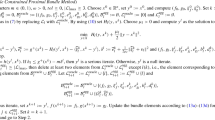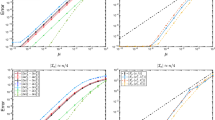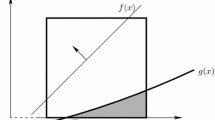Abstract
In this work, we describe the efficient use of improved directions of negative curvature for the solution of bound-constrained nonconvex problems. We follow an interior-point framework, in which the key point is the inclusion of computational low-cost procedures to improve directions of negative curvature obtained from a factorisation of the KKT matrix. From a theoretical point of view, it is well known that these directions ensure convergence to second-order KKT points. As a novelty, we consider the convergence rate of the algorithm with exploitation of negative curvature information. Finally, we test the performance of our proposal on both CUTEr/st and simulated problems, showing empirically that the enhanced directions affect positively the practical performance of the procedure.


Similar content being viewed by others
Notes
It is important to remark that, although MCF is a procedure to compute DNC, we always force \(d_n^k = 0\) for this choice of the \(\mathbf {IA}\) algorithm. This is equivalent to an MCF method, without including DNC explicitly.
Note that our goal is not to compare results obtained from both methods. Rather, we aim to show empirical performance gains are achieved by including the enhanced order information within an optimisation algorithm.
By “better minimum” we mean a significant relative reduction in the value of f(x).
Note that good CT values are obtained for \(\mathbf {IA}_{\mathbf {MCF}}^{(\infty )}\) due to the use of built-in MATLAB function eig for eigenvalue decomposition, especially efficient for small problems.
References
Bazaraa, M.S., Sherali, H.D., Shetty, C.M.: Nonlinear Programming: Theory and Algorithms, 3rd edn. Wiley, Hoboken, New Jersey (2006)
Fiacco, A.V., McCormick, G.P.: Nonlinear Programming: Sequential Unconstrained Minimization Techniques. Research Analysis Corporation, McLean. Reprinted by SIAM in 1990, Mc Lean, Virginia (1968)
Gill, P.E., Murray, W.: Newton-type methods for unconstrained and linearly constrained optimization. Math. Progr. 7(1), 311–350 (1974)
Fletcher, R., Freeman, T.L.: A modified Newton method for minimization. J. Optim. Theory Appl. 23(3), 357–372 (1977)
Mukai, H., Polak, E.: A second order algorithm for the general nonlinear programming problem. J. Optim. Theory Appl. 4(26), 515–532 (1978)
McCormick, G.: A modification of Armijo’s step-size rule for negative curvature. Math. Progr. 13(1), 111–115 (1977)
Moré, J.J., Sorensen, D.C.: On the use of directions of negative curvature in a modified Newton method. Math. Progr. 16(1), 1–20 (1979)
Goldfarb, D.: Curvilinear path steplength algorithms for minimization which use directions of negative curvature. Math. Progr. 18(1), 31–40 (1980)
Moguerza, J.M., Prieto, F.J.: An augmented Lagrangian interior-point method using directions of negative curvature. Math. Progr. 95(3), 573–616 (2003)
Sanmatías, S., Vercher, E.: A generalized conjugate gradient algorithm. J. Optim. Theory Appl. 98(2), 489–502 (1998)
Moguerza, J.M., Prieto, F.J.: Combining search directions using gradient flows. Math. Progr. 96(3), 529–559 (2003)
Hager, W.W., Zhang, H.: A new conjugate gradient method with guaranteed descent and an efficient line search. SIAM J. Optim. 16(1), 170–192 (2005)
Sun, J., Yang, X., Chen, X.: Quadratic cost flow and the conjugate gradient method. Eur. J. Oper. Res. 164(1), 104–114 (2005)
Andreani, R., Birgin, E.G., Martínez, J.M., Schuverdt, M.L.: Second-order negative-curvature methods for box-constrained and general constrained optimization. Comput. Optim. Appl. 45(2), 209–236 (2010)
Murray, W., Ng, K.M.: An algorithm for nonlinear optimization problems with binary variables. Comput. Optim. Appl. 47(2), 257–288 (2010)
Cartis, C., Gould, N.I.M., Toint, P.L.: Complexity bounds for second-order optimality in unconstrained optimization. J. Complex 28(1), 93–108 (2012)
Curtis, F.E., Robinson, D.P.: Exploiting negative curvature directions in stochastic optimization (2017). arXiv:1703.00412
Gill, P.E., Kungurtsev, V., Robinson, D.P.: A stabilized SQP method: global convergence. IMA J. Numer. Anal. 37, 407–443 (2017)
Gill, P.E., Kungurtsev, V., Robinson, D.P.: A stabilized SQP method: superlinear convergence. Math. Progr. 1–42 (2017)
Bunch, J.R., Parlett, B.N.: Direct methods for solving symmetric indefinite systems of linear equations. SIAM J. Numer. Anal. 8(4), 639–655 (1971)
Gill, P.E., Murray, W., Wright, M.H.: Practical Optimization. Academic Press, Bingley, UK (1981)
Gould, N.I.M., Lucidi, S., Roma, M., Toint, P.L.: Exploiting negative curvature directions in linesearch methods for unconstrained optimization. Optim. Method Softw. 14(1), 75–98 (2000)
Boman, E.G., Murray, W.: An iterative approach to computing directions of negative curvature. In: Proceedings of the Fifth Copper Mountain Conference on Iterative Methods (1998)
Olivares, A., Moguerza, J.M.: Improving directions of negative curvature in an efficient manner. Ann. Oper. Res. 166(1), 183–201 (2009)
Guo, C.H., Higham, N.J., Tisseur, F.: An improved arc algorithm for detecting definite Hermitian pairs. SIAM J. Matrix Anal. Appl. 31(3), 1131–1151 (2009)
Mehrotra, S.: On the implementation of a primal-dual interior point method. SIAM J. Optim. 2(4), 575–601 (1992)
Gay, D.M., Overton, M.L., Wright, M.H.: A primal-dual interior method for nonconvex nonlinear programming. In: Yuan, Y. (ed.) Advances in Nonlinear Programming, pp. 31–56. Kluwer Academic, Dordrecht (1998)
Wright, M.: Some properties of the Hessian of the logarithmic barrier function. Math. Progr. 67(1), 265–295 (1994)
Stewart, G.W., Sun, J.: Matrix Perturbation Theory. Academic Press, London, UK (1990)
Forsgren, A., Gill, P.E., Murray, W.: Computing modified Newton directions using a partial Cholesky factorization. SIAM J. Sci. Comput. 16(1), 139–150 (1995)
Olivares, A., Moguerza, J.M., Prieto, F.J.: Nonconvex optimization using negative curvature within a modified linesearch. Eur. J. Oper. Res. 189(3), 706–722 (2008)
Sanmatías, S., Roma, M.: Un método de búsqueda lineal con direcciones combinadas para la optimización irrestringida. In: Actas del XXVI Congreso Nacional de Estadística e Investigación Operativa (2001)
Benchakroun, A., Dussault, J.P., Mansouri, A.: A two parameter mixed interior-exterior penalty algorithm. ZOR—Math. Methods Oper. Res. 41(1), 25–55 (1995)
Dussault, J.P.: Numerical stability and efficiency of penalty algorithms. SIAM J. Numer. Anal. 32(1), 296–317 (1995)
Forsgren, A., Gill, P.E.: Primal-dual interior methods for nonconvex nonlinear programming. SIAM J. Optim. 8(4), 1132–1152 (1998)
Birgin, E.G., Haeser, G., Ramos, A.: Augmented Lagrangians with constrained subproblems and convergence to second-order stationary points. Optimization Online (December 2016). http://www.optimization-online.org/DB_HTML/2016/12/5758.html
Gould, N.I.M., Orban, D., Toint, P.L.: CUTEr and SifDec: a constrained and unconstrained testing environment, revisited. ACM Trans. Math. Softw. 29(4), 373–394 (2003)
Byrd, R.H., Schnabel, R.B., Shultz, G.A.: Approximate solution of the trust region problem by minimization over two-dimensional subspaces. Math. Progr. 40(1), 247–263 (1988)
El-Bakry, A.S., Tapia, R.A., Tsuchiya, T., Zhang, Y.: On the formulation and theory of the Newton interior-point method for nonlinear programming. J. Optim. Theory Appl. 89(3), 507–541 (1996)
Yamashita, H., Yabe, H.: Superlinear and quadratic convergence of some primal-dual interior point methods for constrained optimization. Math. Progr. 75(3), 377–397 (1996)
Moguerza, J.M., Olivares, A., Prieto, F.J.: A note on the use of vector barrier parameters for interior-point methods. Eur. J. Oper. Res. 181(2), 571–585 (2007)
The MathWorks: MATLAB Release 2016b. The MathWorks, Inc., Natick, Massachusetts, United States. (2016). http://www.mathworks.com/
Dolan, E.D., Moré, J.J.: Benchmarking optimization software with performance profiles. Math. Progr. 91(2), 201–213 (2002)
Acknowledgements
This work has been partially supported by research projects GROMA (MTM2015-63710-P), PPI (RTC-2015-3580-7) and UNIKO (RTC-2015-3521-7), funded by the Spanish Ministry of Economy and Competitiveness, and the methaodos.org research group at URJC. This work was completed while the first author was visiting KTH, supported with grants from URJC’s postdoctoral programmes. We are also grateful to Alberto Olivares, from URJC, for his support with the code and helpful comments and discussions.
Author information
Authors and Affiliations
Corresponding author
Additional information
Communicated by Alexey F. Izmailov.
Rights and permissions
About this article
Cite this article
Cano, J., Moguerza, J.M. & Prieto, F.J. Using Improved Directions of Negative Curvature for the Solution of Bound-Constrained Nonconvex Problems. J Optim Theory Appl 174, 474–499 (2017). https://doi.org/10.1007/s10957-017-1137-9
Received:
Accepted:
Published:
Issue Date:
DOI: https://doi.org/10.1007/s10957-017-1137-9




